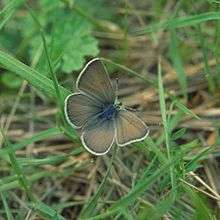Fender's blue butterfly
| Fender's blue butterfly | |
|---|---|
 | |
| Scientific classification | |
| Kingdom: | Animalia |
| Phylum: | Arthropoda |
| Class: | Insecta |
| Order: | Lepidoptera |
| Family: | Lycaenidae |
| Subfamily: | Polyommatinae |
| Genus: | Icaricia |
| Species: | Icaricia icarioides |
| Subspecies: | I. i. fenderi |
| Trinomial name | |
| Icaricia icarioides fenderi (Macy, 1931) | |
Fender's blue butterfly (Icaricia icarioides fenderi syn. Plebejus icarioides fenderi[1]) is an endangered subspecies of butterfly endemic to the Willamette Valley of northwestern Oregon, United States. The species was first documented in the 1920s and was described to science in 1931 by biologist Ralph Macy. He named it for his friend, Kenneth Fender, an entomologist and mail carrier. The species was not seen after the 1930s and was presumed extinct. Small populations were rediscovered in 1989. Its eponym, Fender, had died nine years earlier.[2] In January 2000, Fender's blue butterfly was added to the Endangered Species List by the U.S. Fish and Wildlife Service. The largest known populations now exist in the Baskett Slough National Wildlife Refuge. A 2014 study reintroduced this species to William L. Finley National Wildlife Refuge.[3]
Fender's blue butterfly is host-specific on Kincaid's lupine, a rare subspecies of the common sulphur lupine. The adult deposits its eggs on the plant in spring. After emerging and feeding, the larva winters in the root system. In spring it continues to feed before undergoing metamorphosis. As an adult it lives for no more than ten days, during which time it mates and the female seeks Kincaid's lupines on which to oviposit. The lupine's habitat has been reduced by agriculture and urbanization, and only isolated and protected lands support enough area for populations to persist.
References
- ↑ Plebejus icarioides fenderi. NatureServe. 2012.
- ↑ News release: endangered butterfly needs proper habitat, special nectar. Public Affairs & Communications. University of California, Santa Barbara. June 8, 2000.
- ↑ Rare butterfly back in Willamette Valley refuge. Corvallis Gazette-Times May 23, 2014.
External links
- Fender's blue butterfly (Icaricia icarioides fenderi). US Fish and Wildlife Service.
- Species Fact Sheet: Fender's blue butterfly (Icaricia icarioides fenderi). Oregon Office, US Fish and Wildlife Service.
- Double jeopardy: Endangered butterfly depends on endangered plants. Environmental News Network. CNN.com June 26, 2000.
